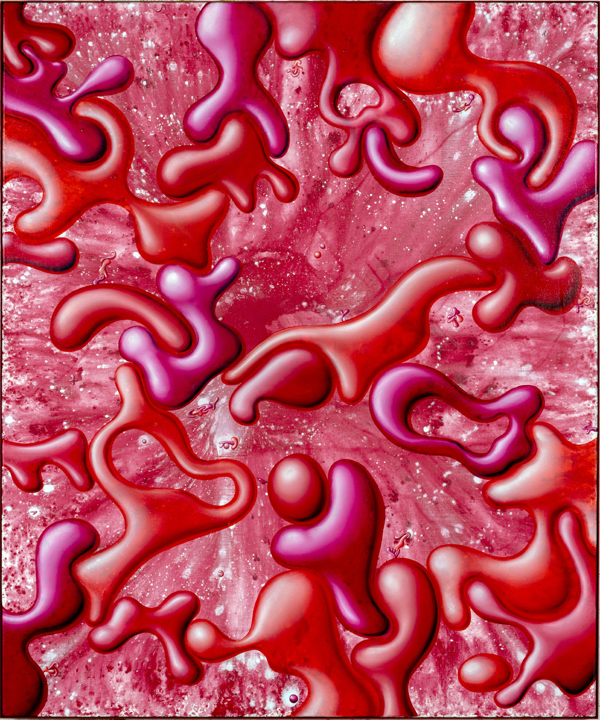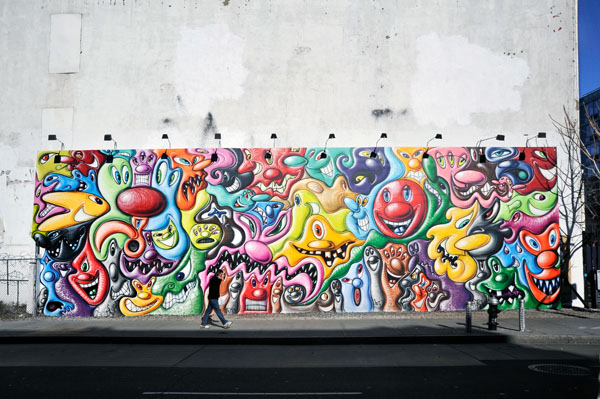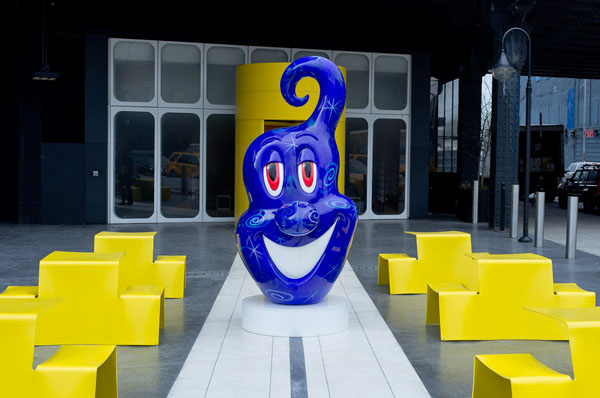Visionary contemporary artist Kenny Scharf got his start in New York City in the early 1980s, burgeoning on the downtown art scene alongside friends Keith Haring, Jean-Michel Basquiat, and John Sex -- to name but a few. A Los Angeles native, Scharf ascribes his inspiration to his California upbringing in 1960s. His works mirror his fascination with pop culture and technology by creating fantastical cosmic imagery; an aesthetic Scharf refers to as "Pop Abstract Surrealism."
Scharf's newest exhibition opens tomorrow at the Paul Kasmin Gallery. The set of ten monochromatic paintings, inspired by Color Field masterworks, will operate as a backdrop to three enormous fiberglass structures -- one of which, "Squirtz", made it's public debut outside The Standard, High Line two weeks prior to his exhibition opening.
"Squirtz"
Scharf's works have been shown both in museums and galleries worldwide, including the Whitney Museum of American Art, MOCA Los Angeles, and Stedelijk Museum. He is currently represented by Honor Fraser Gallery in Los Angeles, as well as Paul Kasmin Gallery in New York. We spoke to Kenny about his thoughts on art elitism, psychedelic car washes, and Kolors.
Let's talk a little bit about your creative process with this particular exhibition and how it differs from shows you've had in the past.
Well, I always like to evolve. This show in particular is a big new direction with these sculptures. They're very, what can I say, slick maybe? I've been wanting to make these kind of more fabricated, really glossy, big [pieces of art], but it costs money to produce. I haven't been able to do it, and now I am and it's very exciting to see it happen. It looks great! I'm really thrilled.
[With] the paintings, I have many different styles of paintings. This is a much more abstract style. What I had in mind was it would be a great, in a way, backdrop for the sculptures. When you see the room, you'll see just these blocks of color without a lot of imagery behind the sculptures. I didn't want to interfere with the sculptures. But then when you actually come up to the paintings closely, I think there's plenty to see. There are lots and lots of details, and from a distance you don't really see it. So, I think it kind of works two ways. I think I'm just showing another side of myself. It's obviously me, but I think that people will think that I'm definitely going in a new, bigger direction.
"Squirtz" made its debut in front of The Standard two weeks prior to the exhibition opening. I wanted to talk about your interest in street art and accessibility. I know it's something that's important to you as an artist, and a sentiment that was shared by your friend Keith Haring.
I've always been excited about art that's accessible. When I first came to New York back in the late '70s, that's when I met Keith and Basquiat, and my group. We were all very young artists and we wanted to be known and be shown, and we realized pretty quick that galleries weren't going to be interested in what we were doing. I mean, why should they be? We were just kids. Also, the prevailing style of when we arrived in the late '70s was, I guess you'd call it minimal. So we were kind of a backlash to what I call "art elitism," where the more esoteric the art is, the better. We were kind of going against that. It's not that we didn't want to appeal to an elite, educated art audience, but we didn't want to exclude the public.
Part of what I do and what I want to do is I want to bring art into the everyday life. If you can take ordinary just walking in the street and you're confronted by something, that might change your day -- it might inspire you. It's not just something for somebody to [make a point of] going to a museum or a gallery to see art, it kind of gets in your face in your everyday life, which I find very exciting. I want to enter people's everyday humdrum, let's say, existence, and give a little spark or a little inspiration. And also, I'm not speaking for all artists, but you want to get out there. You want people to see what you do and doing a mural on the street, you're going to get a lot more viewers than [only] someone who made a point of going to a gallery.

"Red"
That's very much the case with say, for example, your mural on the Bowery. It's very much in your face. It's very colorful, very engaging.
Oh, yeah. I think on that corner like 20 thousand cars an hour go by there. I mean, that's a huge audience.
Speaking of cars and art accessibility, you've talked before about wanting to establish a drive-through museum. Is that idea still in the works?
It's a dream of mine and I actually have plans all drawn up for it. It was my idea because I'm from LA and actually live there as well, even though I made my name in New York. I feel that LA wants to be number one really bad, and you can't complete with the Museum of Modern Art, and the Metropolitan, and the Whitney. You just can't -- no matter how hard you try.
I feel like rather than compete with what New York does so well, what does LA have that New York doesn't have? Well, one of my favorite pieces of architecture in LA are the carwashes. Especially, they have the ones with like space age architecture -- they were probably built in the late '50s. I've always loved these structures. I always thought it would be a great thing to do an art carwash. So you can actually go and get your car washed, but while you're sitting around waiting you can walk in that hallway where you look at the cars going through the window, and that could be changing exhibitions. But I have this idea; you know when you're able to sit in the car?
Totally.
I want to make that almost like a ride. You can sit in your car and you can have this crazy light show and this psychedelic [experience]. Maybe a there'd be a little coffee shop at the end. When you're waiting for your car you can have some coffee or something to drink, and people who work there would be dressed in certain fashions. And then there'd be a store where you could buy all the cool things for your car made by the artists.

Photo © Martha Cooper
I love this idea!
Wouldn't that be fun? Everyone in LA, they all need to wash their cars. It's a boring, humdrum thing that you have to do and it's like, "Ugh, I don't want to wash my car." [But instead, they'd say] "Oh, let's go wash our car. I'm going to wash my car!" [Laughs]
So having just finished Kolors, what are you working on moving forward?
I'm doing a mural in a week or two, a nice-sized mural in a great location on the West Side Highway and 14th Street, so that's exciting. I'm constantly doing new stuff. I'm always excited. I'm a one-man tornado.
Kolors will be on view April 4-May 4, 2013 at 515 West 27th Street, New York. All photos courtesy of the artist and Paul Kasmin Gallery.
